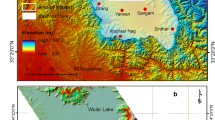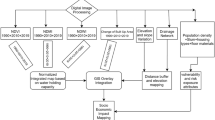Abstract
During November–December 2015, very heavy rainfall caused severe flood in Southern Tamil Nadu that resulted in severe damages with huge economic losses as per news agency Times of India. Remote sensing data from Sentinel-1 synthetic aperture radar (SAR) and Landsat-8. Operational land imager (OLI) images together with ancillary information such as rainfall and demographic data were used in the current study to assess the extent and impact of flooding. The SAR data are used to map the flood or inundation zones. Landsat-8 OLI is used to extract built-up area affected by the flood employing three methods: built-up area extraction method (BAEM), BAEM with Enhanced Built-up and Bareness Index (EBBI), and modified Normalized Difference Built-up Index (NDBI) approach. The classification accuracies obtained for these three approaches were 89, 83.5, and 78% for BAEM (using EBBI), BAEM, and NDBI, respectively. Aerial comparison of built-up area extracted using BAEM (using EBBI) shows the best accuracy with respect to the built-up area obtained from very high-resolution imagery. This extracted built-up area BAEM (using EBBI) method was used to estimate the extent of inundation covering the built-up area. Further the flooding risk at village level was assessed using the population density and flooding area. Built-up area extracted was also overlaid with flooding area to highlight actual built-up areas under risk due to flood.







Similar content being viewed by others
References
Ahmad, R., & Singh, R. P. (2002). Comparison of various data fusion for surface features extraction using IRS pan and LISS-III data. Advances in Space Research, 29, 73–78.
Bhatti, S. S., & Tripathi, N. K. (2014). Built-up area extraction using Landsat 8 OLI imagery. GISci Remote Sens., 51(4), 445–467. https://doi.org/10.1080/15481603.2014.939539.
CEOS (2003). Geohazards Team Report. Committee on Earth Observation Satellites (CEOS). Integrated Global Observing Strategy (IGOS).
Congalton, R. G. (1991). A review of assessing the accuracy of classifications of remotely sensed data. Remote Sens Env., 37, 35–46.
Deng, C., & Changshan, W. (2013). A spatially adaptive spectral mixture analysis for mapping subpixel urban impervious surface distribution. Remote Sens Env., 133, 62–70.
FEMA. (2004). HAZUS-MH. US Federal Emergency Management Agency: FEMA’s Methodology for Estimating Potential Losses from Disasters.
FEMA (2010). National Flood Insurance Programme. US Federal Ergency Management Agency.
Gitelson, A. A., & Kaufman, Y. J. (1998). MODIS NDVI optimization to fit the AVHRR data series - spectral considerations. Remote Sens Env., 3, 343–350.
Gupta, R. P., Tiwari, R. K., Saini, V., & Srivastava, N. (2013). A Simplified Approach for Interpreting Principal Component Image. Adv Remote Sens., 2, 111–119.
He, C., Peijun, S., Xie, D., & Yuanyuan, Z. (2010). Improving the normalized difference built-up index to map urban built-up areas using a semiautomatic segmentation approach. Remote Sens Lett., 1, 213–221.
IGOS (2007). Geohazards Earth Observation Requirements. Integrated Global Observing Strategy (IGOS). Geohazards initiative. BRGM/RP 55719-FR.
IPCC (2014). Barros, V.R., C.B. Field, D.J. Dokken, M.D. Mastrandrea, K.J. Mach, T.E. Bilir, M. Chatterjee, K.L. Ebi, Y.O. Estrada, R.C. Genova, B. Girma, E.S. Kissel, A.N. Levy, S. MacCracken, P.R. Mastrandrea, and L.L.White (eds.). Climate Change 2014: Impacts, Adaptation, and Vulnerability. Part B: Regional Aspects. Contribution of Working Group II to the Fifth Assessment Report of the Intergovernmental Panel on Climate Change. Cambridge University Press, Cambridge, United Kingdom and New York, NY, USA, pp. 688.
IWMI (2015). Mapping Floods in Cuddalore (Tamil Nadu) using Sentinel-1 Satellite Images.
Jawak, S., & Luis, A. J. (2013). A comprehensive evaluation of PAN sharpening algorithms coupled with resampling methods for image synthesis of very high resolution remotely sensed satellite data. Advances in Remote Sensing, 2, 332–344.
Jolliffe, I. T. (1986). Graphical Representation of Data Using Principal Components. In: Principal Component Analysis. Springer Series in Statistics. Springer, New York, NY
Joyce, K. E., Belliss, S. E., Samsonov, S. V., McNeill, S. J., & Glassey, P. J. (2009). A review of the status of satellite remote sensing and image processing techniques for mapping natural hazards and disasters. Progress in Physical Geography, 33, 183–207.
Kawamura, M., Jayamana, S., & Tsujiko, Y. (1996). Relation between social and environmental conditions in Colombo Sri Lanka and the urban index estimated by satellite remote sensing data. International Archives of Photogrammetry and Remote Sensing, 31(B7), 321–326.
Mahendra, R. S., Mohanty, P. C., Bisoyi, H., Kumar, T. S., & Nayak, S. (2011). Assessment and management of coastal multi-hazard vulnerability along the Cuddalore–Villupuram, east coast of India using geospatial techniques. Ocean and Coastal Management, 54(4), 302–311.
Richards, J. A. (2013). Remote sensing digital image analysis: An introduction (5th ed.). New York: Springer.
Rikimaru, A., & Miyatake, S. (1997). Development of forest canopy density mapping and monitoring model using indices of vegetation, bare soil and shadow. In 18th Asian conference on remote sensing (ACRS) 1997, Kuala Lumpur, Malaysia (Vol. 3, pp. 20–25).
Schumann, G., Matgen, P., Pappenberger, F., Hostache, R., Puech, C., Hoffmann, L., et al. (2007). High-resolution 3-D flood information from radar for effective flood hazard management. IEEE Transactions on Geoscience and Remote Sensing, 45, 1715–1725.
Showengerdt, R. A. (1980). Reconstruction of multispatial, multispectral image data using spatial frequency contents. Photogrammetric Engineering and Remote Sensing, 46, 1325–1334.
Teillet, P. M., Staenz, K., & William, D. J. (1997). Effects of spectral, spatial, and radiometric characteristics on remote sensing vegetation indices of forested regions. Remote Sensing of Environment, 61, 139–149.
Tralli, D. M., Blom, R. G., Zlotnicki, V., Donnellan, A., & Evans, D. L. (2005). Satellite remote sensing of earthquake, volcano, flood, landslide and coastal inundation hazards. ISPRS Journal of Photogrammetry and Remote Sensing, 59, 185–198.
USGS. (2013a). What are the best Landsat spectral bands for use in my research? https://www.usgs.gov/faqs/what-are-best-landsat-spectral-bands-use-my-research?qt-news_science_products=0#qt-news_science_products. Accessed 23 July 2018.
USGS. (2013b). How do I rescale Landsat Level-1 digital numbers to reflectance, radiance, and brightness temperature? https://www.usgs.gov/faqs/how-do-i-rescale-landsat-level-1-digital-numbers-reflectance-radiance-and-brightness?qt-news_science_products=0#qt-news_science_products. Accessed 23 July 2018.
Wang, Z., Djemel, Z., Costas, A., Li, D., & Li, Q. (2005). A comparative analysis of image fusion methods. IEEE Transactions on Geoscience and Remote Sensing, 43, 1391–1402.
Welch, R. (1982). Spatial resolution requirements for urban studies. International Journal of Remote Sensing, 3, 139–146.
Westen, C. J. (2013). Remote sensing and GIS for natural hazards assessment and disaster risk management. Treatise on Geomorphology, 3, 259–298. https://doi.org/10.1016/B978-0-12-374739-6.00051-8.
Xu, H. (2005). A study on information extraction of water body with the modified normalized difference water index (MNDWI). J Remote Sens., 9, 511–517.
Xu, H. (2008). A new index for delineating built-up land features in satellite imagery. International Journal of Remote Sensing, 29, 4269–4276.
Zha, Y., Gao, J., & Ni, S. (2003). Use of normalized difference built-up index in automatically mapping urban areas from TM imagery. International Journal of Remote Sensing, 24, 583–594.
Zhangyan, J., Yunhao, C., & Jing, L. (2006). On urban heat island of Beijing based on landsat TM data. Geo-spatial Information Science, 9, 293–297.
Zhao, H., & Chen, X. (2005). Use of normalized difference bareness index in quickly mapping bare areas from TM/ETM+. In Proceedings of 2005 IEEE international geoscience and remote sensing symposium, 2005. IGARSS ‘05, Seoul, 2005 (pp. 1666–1668).
Acknowledgements
The authors would like to thank USGS for making Landsat data available in open domain, European Space Agency for sharing Sentinel-1 SAR data through ESA’s online facility, and ECMWF for precipitation rate data. Thanks are to Director INCOIS for facility and encouragement. This is INCOIS contribution number 338.
Author information
Authors and Affiliations
Corresponding author
Additional information
Publisher's Note
Springer Nature remains neutral with regard to jurisdictional claims in published maps and institutional affiliations.
About this article
Cite this article
Mohanty, P.C., Panditrao, S., Mahendra, R.S. et al. Geospatial Assessment of Flood Hazard Along the Tamil Nadu Coast. J Indian Soc Remote Sens 47, 1657–1669 (2019). https://doi.org/10.1007/s12524-019-01012-7
Received:
Accepted:
Published:
Issue Date:
DOI: https://doi.org/10.1007/s12524-019-01012-7




